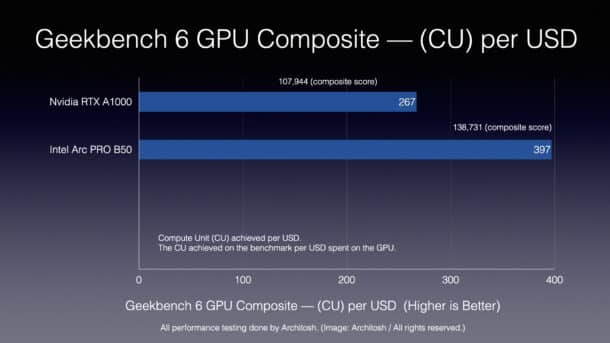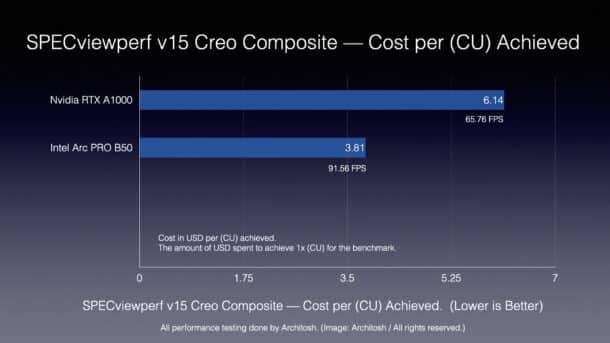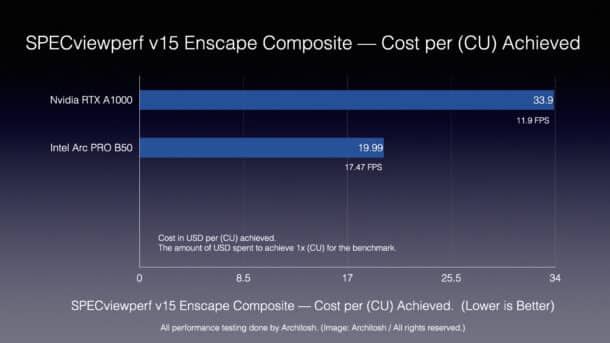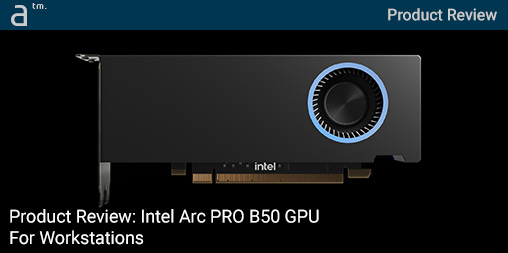Continued from page 2
Economics Metrics
GPU Economics
Our GPU economics charts are partial and selective, but hopefully informative. This kind of metric allows you to compare the value proposition of different chips, especially in isolation, to a specific application or type of workflow. However, one must keep in mind that benchmark scores alone do not tell the whole story of “value” or “performance,” as overall system performance impacts GPU performance. Furthermore, workstation-class GPUs offer other tangible and intangible benefits, including the certification of professional applications (which the Intel B50 has).
Since we have numerous benchmarks to test, which ones do you select for the performance-per-dollar calculation and comparison? For this review—and for the AEC audience on Architosh—we have selected three:
- (1) Creo (OpenGL-based) Composite Test
- (2) Geekbench GPU (composite OpenCL and Vulkan) Tests
- (3) SPECviewperf v.15 Enscape Sub-Test
These three provide an optimal balance between general computing, ML/AI, OpenGL-based rendered viewport performance common to BIM and 3D modeling, and rendering performance (especially interactive).
About Computation
Unlike our last GPU review article, as noted in the GPU Economics section on page one, we are comparing GPUs on two different metrics that are really just inverses of each other. In this first Geekbench 6 GPU Composite chart, we are looking at the Compute Unit (CU) achieved per USD. For every dollar you spend on either of these GPUs, what CU do you achieve on the Geekbench 6 GPU benchmark composite scores? The calculation looks like this:
Compute Unit (CU) per USD = benchmark score / cost of the GPU
In looking at the “value” delivered by the Intel Arc PRO B50, for overall GPU performance across a variety of workloads, including machine learning (ML) for AI, we can see that the B50 delivers outstanding value against its nearest Nvidia RTX rival, the A1000 GPU. In the chart below, longer is better, and one USD earns you the following score value on the composite scores of the Geekbench 6 GPU benchmark. On a performance-per-USD basis, the Intel GPU is 48% better across general GPU compute.

Chart 10: Geekbench 6 GPU Composite scores. (longer bar is better) In this GPU economics chart, the Compute Unit (CU) achieved per one (1x) USD is shown between the two GPUs. (Image: Architosh / All rights reserved).
For the next two GPU economics charts, we focus on OpenGL performance (or similar lower-level API shaded with edges graphics with and without AA (anti-aliasing) and interactive and photorealistic rendering graphics. In modern BIM and 3D modeling workflows, from Rhino and SketchUp to all the major BIM authoring tools, this combination of graphics rendering is predominant.
In the next two charts, we look at the cost in USD per CU achieved. This inverts the formula above and is identical to the GPU econ charts in our prior reviews, such as here. The formula is:
Cost in USD per Compute Unit (CU) = cost of GPU / benchmark score
On a cost-value basis, the Intel Arc PRO B50 delivers stunning value compared to the RTX A1000. For 62 cents on the dollar, the Intel B50 delivers superior performance. Recall that the Creo Composite performance is 39% better than the Nvidia RTX A1000. When we consider the cost difference in conjunction with this OpenGL performance, the Intel GPU becomes very compelling.

Chart X: SPECviewperf v15 — Cost per Computer Unit (CU) Achieved. (lower is better). In this GPU economics chart, the cost in USD to achieve one (1x) computer unit (CU) is shown for each GPU above. (Image: Architosh / All rights reserved).
And this compelling value is also delivered when we examine rendering workflows. Recall that the Intel Arc PRO B50 even outperforms the big sister of the A1000, the Nvidia RTX A2000, on the CompuBench SubD (Catmull-Clark) and SSC (sub-surface scattering).

SPECviewperf v15’s new Enscape Composite scores. (lower is better). In this GPU economics chart, the cost in USD to achieve one (1x) computer unit (CU) is shown for each GPU above. (Image: Architosh / All rights reserved).
And it overtakes the RTX A1000 by a bigger margin than the RTX A1000 GPU overtakes the Apple M3 SoC, or by more than 35%.
The Value Proposition
The value of the Intel Arc PRO B50 for MCAD and OpenGL-based workflows is quite notable compared to the competition referenced in this review, specifically the Nvidia RTX A1000. For example, CDW sells the RTX A1000 for 507.99 USD, while Walmart has it for 421 USD, and PNY has an RTX A1000 that sells for 403.99 USD. As such, we have used a price of 404.00 USD for our GPU economics charts.
As we can see from our GPU economics section, Intel is delivering superb value in this entry-level workstation-class GPU.
Conclusions
Increasingly in AEC workflows, the role of interactive, real-time rendering is significant. Design workflows today are highly 3D-based, and having a 3D or BIM model early in the design process provides not only interactive rendering options but also access to AI-generated imagery that is highly specific to your design process. We were delighted in this review to have access to SPECviewperf v.15’s new Enscape composite tests. Although it was unfortunate that we could not run Cinebench on this GPU card due to compatibility issues, the Blendermark and VRMark performance results also strongly support the Intel Arc PRO B50’s 3D rendering capabilities. One must also remember that this GPU comes with 16 GB of onboard memory.
The one weakness we seemed to detect in the Intel Arc PRO B50 is the performance of OpenGL workflows with AA turned on. That is, anti-aliasing seemed to have a larger impact on the SPECviewperf v.15 Creo suite of tests than we would have preferred to see, though it was still minor in the grand scheme of things. Although we are not primarily focused on MCAD tests for this review, the B50 appears to be a smart investment for economy-oriented MCAD workstations.
We used an “average low price” for the Nvidia RTX A1000 in our GPU econ charts, but the results would not be far off if we equated the two at the “same price.” As for our benchmark tests and those of Intel, they are close on several items, including Enscape and Creo SPECviewperf tests. Besides this GPU’s excellent performance for the price, other strong aspects of the Intel Arc PRO B50 include its 16 GB of GDDR6 memory. This was twice the memory of the Nvidia RTX A1000 (Ampere generation) reference GPU, and becomes meaningful for detailed ray tracing rendering jobs and managing larger textured architectural scenes.
As AI infuses more of our common workloads, the Xᵉ2 GPUs on the Intel card have dedicated AI hardware and matrix engines called Intel Xᵉ Matrix Extension or XMX, and they appear to perform very well on AI workloads like inference. This is another big bonus for this specific Intel GPU.
Recommendations
As much as we love how Nvidia has pushed the limits of GPU performance over the recent years, the CAD market needs competition in the GPU space. It is wonderful to see Intel’s new, professionally oriented Arc Pro-B-Series graphics cards truly deliver on performance-per-dollar metrics over the competition. We tested the B50, but it has a bigger sibling in the B60 with up to 24GB of memory and 20 Ray Tracing Units, not 16 like the B50. We have to give the Intel Arc PRO B50 a big thumbs up. This makes a superb lower-to-mid level GPU for CAD professionals. You can learn more here at Intel.
Pros: This GPU option offers powerful performance per dollar, and even if you could find the Nvidia RTX A1000 at the same or slightly lower price, the Intel Arc PRO B50 has significant performance advantages over it in areas like rendering (charts 3 [Blender], 4, 5, and 9 [Enscape]). It is even faster than the big sister to the RTX A1000, the RTX A2000, in the VRMark (Virtual Reality) test, and in CompuBench rendering performance and subsurface division performance. A significant benefit of this GPU is its 16 GB of GDDR6 memory, as well as its thermal design and power consumption, which require only 70 watts. It powers itself via the PCIe slot. We are also impressed with its OpenGL performance, although a bit less than in rendering workflows. Finally, we can’t deny that Intel’s Xᵉ2 Architecture with its AI hardware and matrix engines delivers compelling ML/AI workload performance over rival GPUs. The Intel Arc Pro B-Series GPUs have ISV certifications, more info here about that.
Cons: The one noticeable performance letdown with the Intel Arc PRO B50 occurred during the SPECviewperf v.15 Creo Composite benchmarks. Overall, the OpenGL performance of the B50 is solid but not as convincingly better over its Nvidia rival, and when AA is turned on, the gap closes a wee bit further. We can see this in SPECviewperf v.15 “Shaded w/ Edges” Creo subtests (Chart 8), where the World Car Shaded with Edges, 4xAA performance is just 13% faster, whereas the composite, which includes a subtest with AA turned off, averages at 15% faster. The only other con is that Cinebench is not compatible with this GPU, so it prevents us from using one of the benchmark mainstays for GPU testing. Perhaps Intel can work on that issue.
Advice: For CAD industry professionals with visualization workloads, the Intel Arc PRO B50 offers a very compelling option, especially when configuring a workstation on a tighter budget or when prioritizing CPU performance over GPU performance, which is what you would do, for example, if your main application and workflow is Autodesk Revit at over 70% of your daily workflow. For large architecture firms outfitting dozens of workstations for workflows that mainly consist of Rhino, SketchUp, Revit, and AutoCAD, this is the GPU I would be considering while leveraging and prioritizing a more expensive GPU.
Cost: 349 USD MSRP
Volume of New Content = 5 — Intel’s Arc PRO B50 offers very good performance for the dollar CAD and 3D rendering graphics performance, offering a compelling mixture of shaded with edges (OpenGL, etc), viewport rendering, and advanced photorealistic 3D rendering and animation capabilities.
Quality of Execution = 4.5 — The Intel GPU card is extremely well-made and executed in an attractive and quiet design. The installation of both hardware and software was simple and well-planned. The Intel graphics driver software was also quite strong, though we spent no time in the article discussing it.
Underlying Technologies = 4.5 — The new Intel chip is built on a TSMC 4nm “N5 node, packs 19.6B transistors, and comes in an all-new card design with improved thermal design and quieter fan performance. The Xᵉ2 Architecture delivers performance across the board with particular strength in rendering and DCC tools like Maya, Blender, Enscape in AEC. It also boasts impressive ML/AI performance.
Future Proofing = 4.5 — The GPU is on the leading edge of graphics technologies, including GDDR6 memory, PCIe Gen 4 or Gen5x8 interface, fast memory bandwidth, and state-of-the-art ML-optimized AI engines. It also ships with 16 GB of memory and excellent video encoding/decoding technology.




